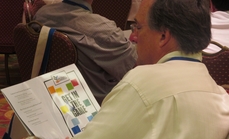At the national New Church Development (NCD) conference during the “Mid Council Strategy” track to discern how to start 1001 new worshiping communities, more definition was given to the new churchwide movement. “For us, there is a reframing of new church development going on,” said Philip Lotspeich, coordinator of church growth for Presbyterian Mission Agency. “1001 is becoming the umbrella for our work.”
As Lotspeich defined what a new worshiping community is, he spoke of cultural shifts happening in the Presbyterian Church (U.S.A.). “Over the last fifty years, much of the impetus to start new churches has been at the presbytery level,” he said. “Before that, it was churches that planted churches. Increasingly, there are entrepreneurial leaders in our congregations who want do this. We’re trying to reform the role of presbyteries to come alongside them—churches planting churches.”
Seeking to make and form new disciples of Jesus Christ is one of the key definitions for what a new worshiping community is. “They can’t just be a cul-de-sac group; disciple-making has to be in their DNA,” Lotspeich said. “We will continue to work not only with new church developments who are on track to become a chartered church, but also with communities who want to do missional endeavors, and with those who don’t look much like the church, but are trying to love others in ways that open the door for folks to know Jesus Christ.”
As local congregations come together with Mid Councils and develop strategic plans on how to empower entrepreneurial leaders to start new worshiping communities, Lotspeich believes “new disciples will come to Christ—in new forms—which will change lives and the world.
When Lotspeich stressed another part of the definition for new worshiping communities—to “develop sustainability in leadership and finances,”—Carolyn Wyatt, director of new church development for Grace Presbytery said, “I know of new immigrant pastors who give their salary back to their community, or don’t take it, to fit within our financial structure and system.” This caused some in the session to wonder if these communities “should have that expectation of financial viability placed on them.” Others asked, “Is it the role of the Mid Council to support them into perpetuity?”
Lotspeich said these were great questions for Mid Councils to wrestle with, as Evangelism and Church Growth Ministries works out details with the Mission Resources Development Committee on what NCD and1001 mission program grants will look like.
“We have a lot to learn from our ecumenical partners in the global church” said Roger Dermody, deputy executive director of Presbyterian Mission Agency, who recently returned from a trip visiting mission partners in Vietnam. “They have very few financial resources, yet they started 124 churches in the last year. We have to look with fresh eyes at the way we start churches.”
Editor’s Note: To read the definition of a “new worshiping community” worked on by Evangelism and Church Growth; Theology, Worship, and Education; and Racial Ethnic Ministries, click here.

